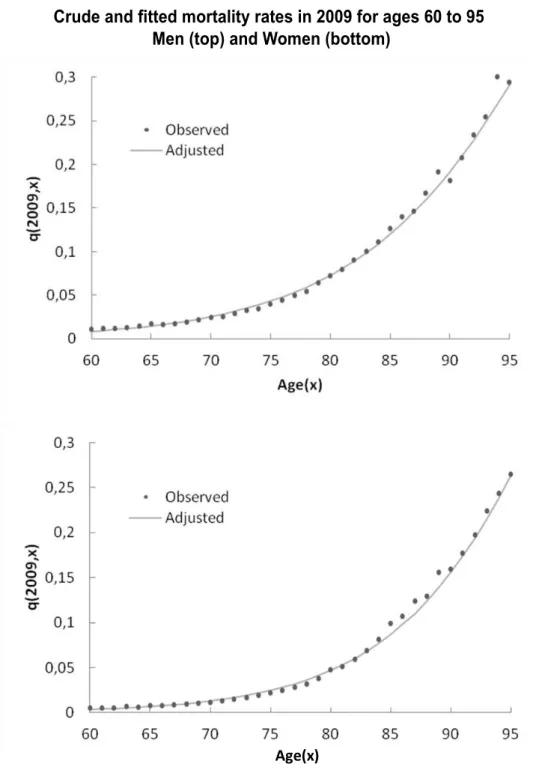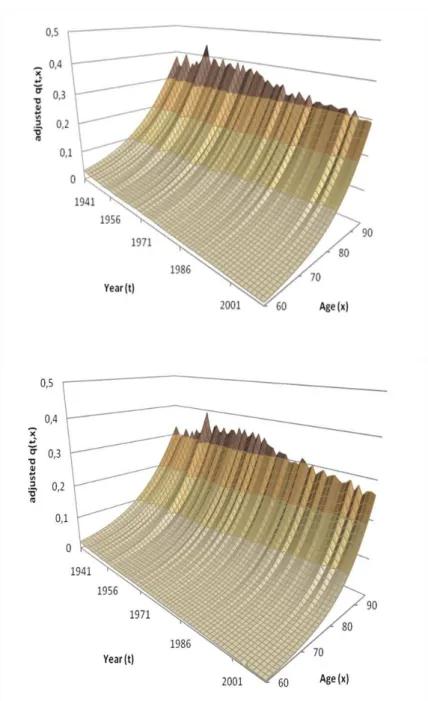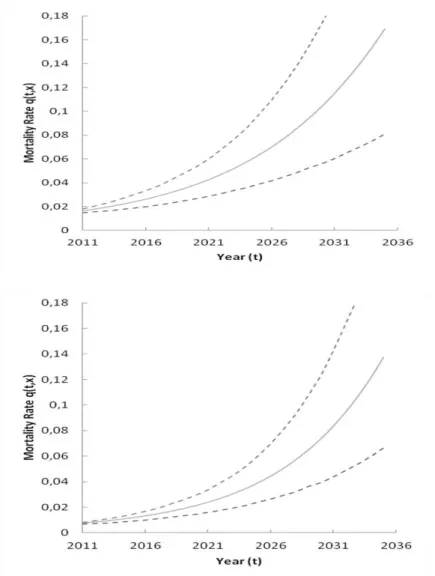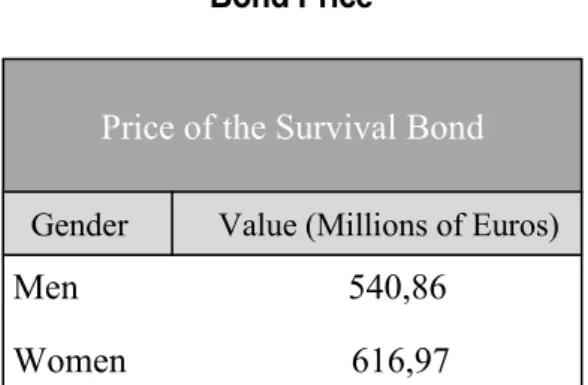HEDGING THE LONGEVITY RISK FOR THE PORTUGUESE POPULATION IN THE BOND MARKET
Rúben Pereira Carlos
Mercer Portugal
Onofre Simões
ISEG - Instituto Superior de Economia e Gestão
Abstract
Increases in life expectancy have been noticeable in recent decades and this is one of the key issues to the annuities industry and to the public pensions system. To address the problem of hedging the longevity risk, several instruments have been discussed within the financial markets in order to find a solution. Many stochastic models have been suggested to fit the evolution of the mortality curve as close as possible, so that these financial instruments can be issued on a solid basis.
In this paper, we discuss and simulate the issue of two longevity bonds with cash flows linked to the evolution of a survival index, built on the Portuguese mortality data. The forecast of mortality rates is per-formed using a two-factor stochastic model, the Cairns-Blake-Dowd (CBD) model. The main objective is to develop a hedging solution to the increases in human longevity in Portugal.
Keywords: Longevity, Survivor bonds, Stochastic mortality models
1. INTRODUCTION
Over the last decades, an unprecedented increase in life expectancy has been observed. According to the National Statistics Institute (INE), life expectancy at age 65 (normal retirement age) increased by 5 years to 18.5 years in Portugal between 1970 and 2009. In the same period life expectancy at birth increased 2.95 years for men and 2.06 years for women, reaching 76.34 years and 82.43 respectively. These values are above the European average (74.7 years for men and 81.5 years for women in 2007).
An increase of this magnitude involves a significant, and not completely anticipated, increase in the expenses associated with long-term benefits, including annuities. For this reason, governments have been reducing the benefits of state pensions and tend to offer incentives for individuals to save for retirement. One innovation in the capital markets is associated with survival (or longevity) bonds, which provide life insurance companies and other pension funds managers with an instrument to hedge this risk. These bonds have been proposed by Burrows and Blake (2001), and pay a coupon that is proportional to the number of survivors in a selected cohort, say the individuals
Figure 1
Life expectancy at birth (years), Portugal, 2001- 2009
aged 65 in the year that the bond is issued. Therefore, the cash flows will diminish over the years.
The trend observed in longevity has multiple implications on economics, social affairs and human development as a whole (see Cutler and Meara 2001; Willets 2004; and Cairns et al. 2008), and it must also be taken into account when pricing financial liabilities, particularly in products that include long-term benefits, as is the case of annuities. To minimize the risk of under/ over estimating the liabilities of a portfolio, the calculation of the present value of the related stream of cash flows requires adequate projections of both the relevant economic variables (inflation, discount rate, pensions increase rate) and the demographic variables (mortality rates, early retirements by illness or disability, existence of dependents, among others). In many studies, such as Pollard (1987) and Booth (2006), stochastic models are used for this purpose. The yearly organization of an International Longevity Risk and Capital Markets Solutions Conference is an important sign of the importance of the issue. Eight conferences have been held already (http://www.cass.city.ac.uk/pages/ longevity-risk), bringing together leaders from industry, scholars and political decision-makers to discuss the assessment of longevity risk and the develop-ment of proposals to find ways of managing it through the financial markets.
Bravo et. al. (2009) argue that, historically, the Portuguese annuities market shows a clear underdevelopment, which is visible in the difference between low demand and high supply. This happens because likely annuitants fear overpricing, due to the use of conservative technical bases, and consider tax incentives to be insufficient. Further, annuities markets are incomplete, illiquid and not safe from extreme events. Alternative investments in the capital markets are seen as more attractive.
Aware of this, annuity suppliers – mostly life insurance companies – have tried different mechanisms to hedge the longevity risk. These have involved classical techniques, risk securitization, or even the creation of a mortality derivatives market. But it was in the financial markets that some innovative solutions emerged, taking advantage of the low correlation between the longevity risk and the existing assets, and thereby making an effective world-wide improvement to hedge longevity.
The purpose of this paper is to calculate the issue price of two bonds with coupons indexed to a longevity index, by gender, based on the mortality data from the Portuguese population. Similar works covering other populations already exist, such as Cairns et al. (2006) or Leppisaari (2009).
tq^x
results are compared with available information on similar studies for other countries. The main conclusions and other thoughts are presented in Section 4.
2. THE SURVIVAL INDEX
The modelling of mortality with stochastic processes can be regarded as a relatively new advance. This development is due to the growing recognition of the uncertainty related to the evolution of mortality, making it necessary to create ways to manage this uncertainty (Pitacco (2003)). In recent years, a variety of models have been proposed by different authors, and there is a vast (and growing) literature on the subject. The work of Lee and Carter (1992) is generally considered the starting point for the wider adoption of stochastic models for mortality in the insurance industry. The development of interest rates models and credit derivatives is also favourable to these ‘modern’ approaches.
Mortality has always been a prime research topic worldwide. Our epoch is no different, but now most researchers are particularly interested in longevity and its consequences at different levels. One possible approach is mortality modelling based on time series (see for example Lee and Carter 1992 and Cairns et al. 2006). Another approach is based on pricing and risk manage-ment concepts analogous to those in the derivatives markets, focusing essen-tially on how to hedge the longevity risk (Cairns et. al. (2008a)).
2.1 CAIRNS-BLAKE-DOWD MODEL
Cairns et. al. (2006) proposed a model (hereafter referred to as CBD) in discrete time, where the probability evolves over the time according to the effects of two random factors and a functional form derived from Perks (1932) law of mortality:
or, likewise,
log tq^x A 1 A 2
1
( )
tq^x (t+ 1 )+
(t+ 1 ) (x+t),(2.2)
(2.1) tq^x= eA 1(t+1)A 2 (t+1) (x+t)
A
e 1 A 2(t+1) (x+t) 1 + (t+1) +
Sx,t tq^x.
1
2 tq^x
t=0
2 1
2
where:
represents the realized mortality probability for the cohort aged
x
at timet
. A (u) and A (u) are stochastic processes assumed to be measurable at timeu
. The factor A (u) affects mortality at all ages in an equal manner, whereas A (u) has an effect on mortality that is proportional to age.Despite its relative simplicity, the CBD model shows a good performance in the works conducted in Cairns et al. (2007; 2008b) and Dowd et al. (2010). These authors always come to the conclusion that the model appears to be robust and biologically reasonable.
As the main objective of our work is to calculate the issue price of two survival (or longevity) bonds with coupons indexed to a longevity index, denoted, divi-ded by gender, it is necessary to forecast the mortality rates
This index represents the proportion of individuals in the population aged
x at time who are still alive in a future period t. It is based on the realized mortality of Portuguese individuals aged 65 in 2010. The split by gender is justified by the structure of the population in Portugal: 48% are men and 52% are women (Source: INE, PORDATA).
Although the first issue of this type of product was actually announced in November 2004 by the European Investment Bank (EIB) and BNP Paribas, Cox et al. (2000) point out that other (not very successful) attempts had been made since 1997.
The bond in our study has a maturity of 25 years and the issue date is December 31, 2010 (t = 0). The CBD model will be used. To fit the processes,
A (u) and A (u) OLS estimation is applied, as in Cairns et al. (2006).
2.2 Data Used - Mortality Database
The Portuguese mortality data is typically published annually, and so it is a common procedure to model mortality data with discrete models. The necessary data were obtained from the Human Mortality Database (HMD) (http://www.mortality.org/).
Looking at Figure 2, it is noticeable that mortality rates have improved for both genders over the observation period in a random way. Throughout the study period, it can be seen that at more advanced ages, there is a decrease in the volatility of the data, which is shown by the decline in mortality peaks. This situation is latent in women. Still, at these ages, we can expect some noise in the fitted model.
Figure 2
2 1
2.3 MEASUREMENT OF THE STOCHASTIC PROCESSES IN THE
CAIRNS-BLAKE-DOWD MODEL
Using mortality data from 1941 to 2009 (the last year available in HMD - given the length of the horizon, the inclusion of 2010 and 2011 would only make a negligible difference, if any) for men and women, linear regressions were performed with Microsoft Excel. The results were statistically significant in all years. Figures 3 and 4, below, display the results of the adjustments.
Figure 3
2 1
1 2
1 2
Figure 4
A
(t)
(top) and A(t)
(bottom) for WomenThese results show a clear downward trend in the process A (t) and an upward trend in the process A (t). The trends are similar for both genders. Cairns et. al. (2006) obtained similar results using data from 1961-2002 for English and Welsh males above the age of 60.
Figure 5 compares the crude mortality rates and the fitted ones for the last year of observation, 2009, males and females.
Figure 5
Crude and fitted mortality rates in 2009 for ages 60 to 95 Men (top) and Women (bottom)
Figure 6 shows the results of the fitted mortality rates for both genders, from 1941 to 2009.
Figure 6
Z (t )∼ N (0,1),
2×1
Z (t )
∈ ℝ
C∈
ℝ2×2
µ
∈
ℝ 2×1T
1 2
Another step is now necessary. Again following the approach used by Cairns et. al.(2006), let us assume that
where is a constant drift vector, is a constant lower trian-gular matrix and is a vector of independent standard normal random variables,
For men
For women
Note that the “volatility” matrix C is derived from the covariance matrix
V=CC using Cholesky decomposition. An important criterion for a good mor-tality model is that it should be biologically reasonable, which is confirmed here: the negative value for µ indicates generally improving mortality; the positive value for µ means that mortality rates at higher ages are improving at a slower rate.
Using equations (2.3), (2.4), (2.5) and A (2009) and A (2009), 25-year forecasts for the model parameters have been made (Figures 7 and 8).
(t+1) =A(t ) + µ +CZ(t+ 1 ) A
⌃
µ = 0,0418
0,00038 V ⌃= 0,0191010,000276 0,000004560,00028
⌃
µ = 0,0644
0,00063 V ⌃= 0,0122050,000181 0,000003240,00018 0,00076
0,13821
0,001998 0
⌃ C =
0,110478
0,001638 0,000750
⌃ C =
(2.3)
(2.4)
,
(2.5)
,
1 2
Figure 7
Means and 95% confidence intervals in the simulated path of A (t) (top)
and A (t) (bottom) from 2011 to 2035 for Men
2
1
Figure 8
Means and 95% confidence intervals in the simulated path of A (t) (top)
and A (t) (bottom) from 2011 to 2035 for Women
tq^x´ = 1,..,25
tq^x N = 10000
2.4 MONTE CARLO SIMULATION 2.4.1 Mortality Rates
It is now possible to simulate the future mortality rates and corresponding survival probabilities for Portuguese men and women aged 65 in the last year of observation, 2009. A Monte Carlo simulation with runs enabled us to find the empirical distribution of for each (with t = 2010 + ). Figure 9 shows the results for men and women.
Figure 9
Sx,t
tq^x´ S65,t
tq^x
We see that the confidence intervals increase in amplitude over the 25 years, and this situation is more evident in men. Thus, the higher the volatility of mortality data, the higher the volatility of the 25-year forecasts. In turn, this leads to a greater uncertainty in forecasts of mortality rates. This is the expected behaviour in long-term forecasts.
2.4.2 Survival Index
Using the amounts just simulated, the construction of the survival index is straightforward, and can be computed by equation (2.6) below:
Equation (2.6) is used to calculate the survival probabilities from the forecasts of annual mortality rates (Figure 10).
Figure 10
Means and 95% confidence intervals for the simulated path of from 2011 to 2035 Men (top) and Women (bottom) aged 65 in 2010
Sx,t+1 Sx,t 1 tm x , t = 0,1,2,...,T = 25
Sx,t
Sx,t
The solid line shows the average forecasted values of , i.e., the ave-rage survival probabilities obtained in the simulations. The broken lines repre-sent the 95% confidence intervals of distribution. It can be seen that the range is very narrow in the first years, widening along the 25-year horizon. Naturally, projections of the survival index are higher in women than in men.
3. BOND VALUATION
3.1 Discounted cash flows - Yield curve data
The term structure of interest rates (yield curve spot rate) is calculated daily by the European Central Bank (ECB) for two sets of bonds: one sample contains AAA-rated euro area central government bonds, i.e. debt securities with the most favourable credit risk assessment. The second dataset contains (AAA-rated and other) euro area central government bonds.
Because the bonds under study for this paper are focused on the Portu-guese market, the second dataset was chosen to proceed with the calcula-tions of the present value of cash flows. It should be noted that the ratings used are provided by Fitch ratings.
to the fraction of people aged 65 at the time of issuance who survive till, at least, 2020.
There is consensus among practitioners that the bonds should be traded on secondary markets and transferred at any time according to their market price. This would be a solution for companies that hold a pension plan with many people, as they can buy this product to hedge the longevity risk of the members of the plan. The goal is to reduce the costs of provisions for the members as well as for retirees.
There are, however, some risks associated with this, which should be taken into account. First, the purchasers of annuities might live longer than the average population of the same age. Second, the company that sells annuities might analyse only a limited set of lives while their customers’ characteristics might be quite different from the population as a whole. In short, by minimizing the overall risk, insurance companies would have the right incentives to develop a thorough analysis on mortality forecasts, which could enable the creation of adequate insurance policies against non-systematic risks.
3.2 BOND EVALUATION
Table 1 finally shows the price of the bond (at par).
Table 1
Bond Price
It is immediate that the cost of hedging the longevity risk for the Portu-guese women is higher than the cost for the male population. This situation is to be expected because women have longer lives. We may also conclude that
Men 540,86 Women 616,97
Price of the Survival Bond
Sx,t
Sx,t
the bonds are designed to hedge the longevity risk to the bondholder, i.e., the holder of the long position. Thus, the issuer will make a profit if the index is lower than anticipated while the bondholder will profit if is higher than expected.
For example, life insurance companies (with regard to the death benefit coverage), pharmaceutical companies and companies that provide services to the elderly population all benefit from the increase in life expectancy - unlike Governments or private companies with a pension plan, who will make a loss when longevity increases.
Thus, longevity bonds are directed to hedge portfolios composed mostly of annuities (pension plans, for example). This is because they are designed to protect the buyer from unexpected improvements in mortality up to the maturity. It is arguable that the horizon of this application is only 25 years, but for bonds with ultra-long maturities, liquidity may raise some hedging difficulties. If the market reacts positively and shows interest, there is always room for more issuances, with different maturities, so that hedgers can make more effective hedging of their portfolio longevity risk. Another positive point is related to the reduction of the basis risk, since the population hedged by annuities and the population included to build the longevity index coincide.
On the other hand, there are some drawbacks that justify why this market is not as liquid as one would wish. Firstly, the amount required to reduce expo-sure to the longevity risk is high, relative to the risk reduction that can be accomplished. Second, potential hedgers might still consider that the basis risk is too high for the investment. This situation is relevant for a country like Portugal, where the annuities market is small. Many Portuguese do not partici-pate in a retirement savings plan, or purchase annuities.
The well-known fact that there are differences between the mortality rates of individuals receiving higher pensions and those who receive lower pensions is another limitation. Indeed, the liabilities of the pension plans are higher (or lower) according to the pension amounts. Naturally, the construction of a sur-vival index for the whole population takes no account of the members’ income, which leads to differences in how the liabilities are hedged. In this case study, the longevity bond coupon payment places equal weight on all the lives of the Portuguese population, resulting in an imperfect hedge.
As a consequence of the above points, when a new financial instrument is developed, it is important to assess how the hedgers will use this instrument to reduce the risk of their business as thoroughly as possible and it is necessary to measure the base risk that they can be subject to. The degree of exposure must be small enough so that there are no liquidity problems.
Sx,t
been discussed. In the case of such products, the most obvious challenge has to do with the existence of investors with a genuine interest in the operation and adequacy between the bonds’ cash flows and their portfolios. Without a doubt, companies investing in this type of bond have to manage the assets and liabilities of their portfolios and consider the liquidity needs by gender. When analysing the longevity risk to which they are subject, the investment in bonds to effectively hedge the risk of their business must be calculated.
4. FINAL THOUGHTS
Trends in longevity have multiple implications on the economic, social and human development of societies. Mortality forecasts become increasingly important as they are crucial to hedge companies’ business risk when they are involved in the longevity market.
In this paper, as in others already cited, we used the CBD model with two parameters, aiming to forecast a mortality curve for a 25-year period in the future. The process was developed in several steps and provided satisfactory results.
Apart from the valuation of two effective longevity bonds, one for men and the other for women, a significant contribution of the study is related to the survival index , which is calculated based on the crude mortality rates published by INE. The rates are reliable and easily accessible, which assures investors that bond issuers cannot manipulate the mortality rates. Using crude mortality rates avoids any arguments against a possible smoothing or adjust-ment.
References:
Booth, H., Hydnman, R.J., Tickle, L., and de Jong, P., (2006), Lee-Carter mortality forecasting: a multi-country comparison of variants and extensions, Demographic Research, 15: 289-310 Bravo, J. M., Corte-Real, P. and Pereira da Silva, C. (2009), “Participating life annuities incorporating
longevity risk sharing arrangements”, Paper for submission to “Prémio Inovação Reforma - Programa Consciência Leve”, Portugal.
Blake, D., and Burrows, W. (2001), Survivor Bonds: Helping to Hedge Mortality Risk, Journal of Risk
and Insurance, 68: 339-348.
Cairns, A.J.G., Blake, D. and Dowd, K. (2006), A Two-Factor Model for Stochastic Mortality with Parameter Uncertainty, The Journal of Risk and Insurance, 73(4): 687-718.
Cairns, A.J.G., Blake, D., Dowd, K., Coughlan, G.D., Epstein, D., Ong, A., and Balevich, I. (2007), “A quantitative comparison of stochastic mortality models using data from England & Wales and the United States”, Working Paper, Heriot-Watt University and Pensions Institute Discussion Paper PI-0701.
Cairns, A.J.G., Blake, D. and Dowd, K. (2008a), Modelling and Management of Mortality Risk: A Review, Scandinavian Actuarial Journal, 2–3: 79–113.
Cairns, A.J.G., Blake, D., Dowd, K., Coughlan, G.D., Epstein, D. and Khalaf-Allah, M. (2008b), “Mortality Density Forecasts: an Analysis of Six Stochastic Mortality Models”, Working Paper, Heriot-Watt University and Pensions Institute Discussion Paper PI-0801.
Cutler, D. and Meara, E. (2001), “Changes in the age distribution of mortality over the 20th century”, NBER Working Paper N. º 8556, NBER.
Dowd K., Cairns A.J.G., Blake D., Coughlan G.D., Epstein D., Khalaf-Allah, M. (2010), Evaluating the goodness of fit of stochastic mortality models, Insurance: Mathematics and Econom-ics, 47 (3): 255-265.
Lee, R. D., and Carter, L. R. (1992), Modeling and forecasting the time series of U.S. mortality,
Journal of the American Statistical Association, 38: 659–671.
Leppisaari, M. (2009), “Stochastic Modelling of Mortality Using Finish Data”, Master’s thesis, Helsinki University of Technology, Finland.
Perks, W. (1932), On Some Experiments in the Graduation of Mortality Statistics, Journal of the
Institute of Actuaries, 63: 12-57.
Pitacco, E. (2003), “Survival Models in Actuarial Mathematics: From Halley to Longevity Risk”, Invited lecture, 7th International Congress Insurance: Mathematics & Economics, ISFA, Lyon, June 2003.
Pollard, J. (1987), Projection of age-specific mortality rate, Population Bulletin of the United Nations, 21/22, 55-69.



